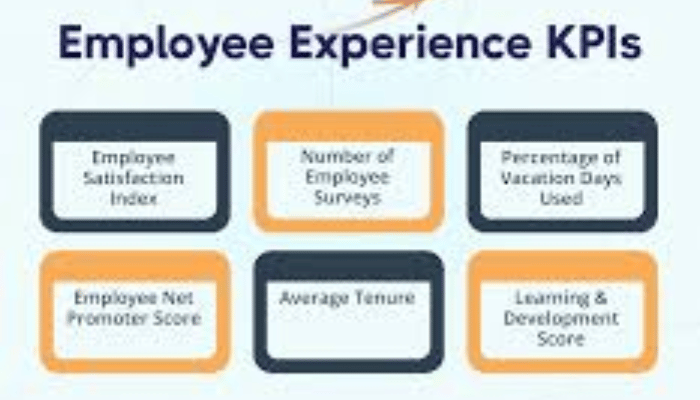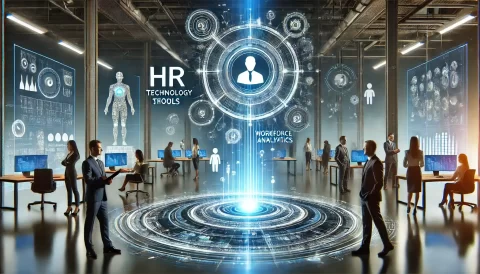HR key performance indicators, or KPIs, are metrics used to gauge the performance of an organization’s Workforce. KPIs, which have long been used in marketing and sales, are now being employed in HR departments, too. Before we analyze the KPI metrics, Let’s clarify what a KPI actually is.
Imagine you’re in a big forest, hunting for hidden treasure. Would you rather wander aimlessly or follow a map that takes you straight to the prize? That’s exactly what HR KPIs do for businesses – they’re like treasure maps leading you to success.
What are HR KPIs?
Traditionally, KPIs (Key Performance Indicators) were used mostly by marketing and sales teams to track success. But now, HR (Human Resources) has joined too. HR KPIs are like a pulse check for your company, showing how well it’s doing in different areas.
“HR KPIs are not just numbers; they’re insights into your company’s heart and soul”.
So, you might be wondering, how do these insights actually impact the workplace? Let’s dive into a real-world scenario to see HR KPIs in action.
How HR KPIs Work?

Let’s say a tech startup called InnovateX is struggling with a large number of employees leaving. They noticed this was a big problem, so they introduced an HR KPI called ‘Employee Satisfaction Score’, through which they asked their employees how happy they were with their jobs.
Most people wanted more flexibility and chances to grow in their careers. So, InnovateX worked to give employees more flexibility and opportunities to grow. And guess what? Not as many people left after that! Read: Customer Success Stories
Using Data to Make Decisions:
Companies have much information, but sometimes they’re unsure how to use it. That’s where HR KPIs step in. They turn all that data into helpful information that helps you make good choices. For example, Lisa, an HR manager at “GreenWorld,” looks at her HR dashboard and sees that employees aren’t happy with their communication. So, she works on that to improve it, and gradually things start to get better! Also Check: How to build diversity inclusion with HR communications
Now, Let’s talk about how to make HR KPIs really help your company.
Making HR KPIs Work for You:
For HR KPIs to be useful, they must be SMART: Specific, Measurable, Achievable, Relevant, and Time-bound. For example, let’s look at ‘Red Rocket,’ a new startup. They set a goal to speed up their hiring process by 20% in six months. And guess what? They did it, and new employees are happier, too! Check here: How to set SMART goals
Think of HR KPIs as your business’s GPS. They help you steer your team through challenges and head towards success. Companies like InnovateX, Career Launcher, GreenWorld, and Red Rocket prove that using data to make decisions isn’t just smart – it’s necessary. So, are you ready to find your company’s treasure map?
Now, get ready for a journey to explore the top 30 HR metrics that will be important in 2024.
Top 30 HR KPI Metrics and Indicators for 2024:

Absenteeism Rate: The absenteeism rate is a crucial HR KPI that measures employee absences’ frequency and duration. By monitoring absenteeism, organizations can identify patterns and trends, assess the impact on productivity, and take proactive measures to improve employee engagement and well-being.
Employee Retention: This is one of the most crucial HR KPIs, the high-value retention rate means that employees are happy with their jobs and will stay, while a low retention rate indicates that employees are not satisfied and may just consider leaving. Tracking this KPI allows organizations to identify problem areas and take corrective action before employees leave, you can measure this key performance indicator by tracking various HR metrics with the help of talent management programs. Check: Strategies for improving employee retention
Employee Satisfaction: This is another key metric that attorneys attract, It’s all about how much employees like their jobs and how eager they are to do well. To find this out, companies ask their workers how they feel – through surveys. You can make and look at these surveys with easy-to-use programs like Qualtrics or SurveyMonkey. The questions in these surveys usually ask about how people feel about the company’s work environment if they’re happy with their job, and if they feel important and respected.
Time to Hire: This is simply the time it takes a company to fill a vacancy. Picture this: DreamTech Inc., a startup about to launch a big product, realizes they need to hire a new software developer quickly. That’s when they use ‘Time to Hire.’ It took them 45 days from start to finish to find the right person for the job. By keeping an eye on this number, they spotted problems in their hiring process, like a job description that wasn’t clear. They fixed these issues and made their hiring process faster to meet their deadline.
Recruitment Costs: This metric tells you how much money the company is spending on hiring new employees, and tracking spending helps you optimize it. A simple way to track this metric is to divide the total spend on recruitment by the total number of employees hired, here you have to take into account, the money spent on advertising agencies and interviews, as well as the cost of training the new employees.
Overtime Hours: Overtime hours are a key HR metric that measures the amount of time employees work beyond their regular working hours. By monitoring overtime hours, organizations can assess workload distribution, identify areas of improvement, and maintain a healthy work-life balance for employees.
Employee Turnover Rate: Employee turnover rate is a critical HR metric that measures the percentage of employees who leave the organization within a specific period. Organizations can identify underlying causes by analysing turnover patterns, implementing retention strategies, and reducing turnover, thereby minimizing the impact on productivity and morale. For example, Company – Skyward Innovations noticed that too many employees left their jobs. So, they looked into it and found that they could improve things by giving people more flexible hours and chances to grow in their careers. After they made these changes, fewer people left their jobs, and the company stayed strong with its top performers.
- Employee Productivity: Employee productivity is a vital HR metric that measures the output and efficiency of employees. By tracking productivity levels, organizations can identify areas for improvement, implement performance management strategies, and enhance overall productivity.
- Training Effectiveness: Training effectiveness is a significant HR metric measuring employee development programs’ return on investment (ROI). Organizations can optimise training resources and ensure a positive ROI by evaluating the impact of training initiatives on employee performance and skill development.
- Benefits Administration: Benefits administration is a crucial HR metric that measures the effectiveness of employee benefits programs. By analyzing employee satisfaction with benefits, organizations can align their offerings with employee needs, attract and retain top talent, and enhance overall employee well-being.
- Training Costs: Training costs are an important HR indicator that measures the financial investment in employee training and development. By tracking training costs, organizations can evaluate the effectiveness of training programs, optimize resources, and ensure a skilled and competitive workforce.
- Employee Engagement: Employee engagement is a vital HR metric that measures employees’ emotional commitment and motivation. By utilizing tools such as surveys and feedback sessions, organizations can measure employee engagement, identify areas for improvement, and implement strategies to enhance engagement and productivity.
- Salary Cost by Department: Salary cost by department is a critical HR metric that measures the financial allocation of salaries across different departments. By tracking salary costs, organizations can identify areas of high expenditure, optimize budget allocation, and ensure equitable resource distribution.
- Talent Satisfaction: Talent satisfaction is an essential HR KPI that measures the level of satisfaction among high-potential employees and key talent. By assessing talent satisfaction, organizations can identify factors impacting retention, implement targeted retention strategies, and ensure the long-term success of their top performers.
- Manager Feedback Score: The manager feedback score is a key HR metric that measures the quality of feedback and communication between managers and employees. By evaluating the manager feedback score, organizations can identify areas for improvement, provide training and development opportunities, and enhance overall employee satisfaction and engagement.
- Cost per Hire: Cost per hire is a critical HR metric that measures the financial investment required to hire a new employee. By analyzing it, organizations can identify cost-saving opportunities, optimize recruitment strategies, and ensure efficient resource allocation.
- Recruiting Conversion Rate: The recruiting conversion rate is an important HR indicator that measures the effectiveness of different recruitment methods in attracting qualified candidates. By tracking it, organizations can evaluate the efficiency of recruitment channels, optimize sourcing strategies, and improve the overall quality of hires.
- Time to Fill: Time to fill is a key HR metric measuring the average time to fill open positions. By reducing the time to fill, organizations can minimize recruitment costs, attract top talent, and ensure a seamless hiring process.
- Diversity Metrics: Diversity metrics are essential HR indicators that measure the representation of diverse groups within the workforce. By tracking diversity metrics, organizations can promote inclusivity, create a diverse and inclusive workplace culture, and harness the benefits of diverse perspectives and experiences.
- Workplace Accidents: Workplace accidents are critical HR metrics that measure the number and severity of workplace incidents. By tracking workplace accidents, organizations can identify safety risks, implement preventive measures, and ensure the well-being and safety of employees.
- Employee Net Promoter Score (NPS): Employee Net Promoter Score (NPS) is a vital HR metric that measures the loyalty and advocacy of employees towards the organization. By measuring employee NPS, organizations can gauge the overall company culture, identify areas for improvement, and foster a positive and engaging work environment.
- 90-Day Failure Rate: The 90-day failure rate is an important HR metric that measures the percentage of new hires who leave the organization within the first 90 days. By analyzing it, organizations can assess the effectiveness of their onboarding and hiring processes, identify areas for improvement, and enhance overall employee retention.
- Training Costs Per Employee: Training costs per employee is a critical HR metric measuring the financial investment in training and development. By analyzing training costs per employee, organizations can evaluate the efficiency of training programs, optimize resources, and ensure a high return on investment.
- Gender Diversity by Role: Gender diversity by role is an essential HR indicator that measures the representation of different genders in leadership positions. By tracking gender diversity by role, organizations can promote gender equality, ensure equal opportunities for career advancement, and create a diverse and inclusive leadership team. For example, Visionary Ventures, a tech company, looked at how many men and women were in leadership roles and saw that there were more men. So, they decided to do something about it. They started programs to help women in tech get better jobs and move up in their careers. Over time, more women started getting leadership roles in the company.
- Dismissal Rate: Dismissal rate is a key HR metric that measures the percentage of dismissed or terminated employees. By analyzing the dismissal rate, organizations can assess the recruitment and employee fit quality, identify improvement areas, and implement strategies to reduce dismissals.
- Average Time Stay: Average time stay is an important HR metric that measures the average duration employees stay with the organization. By monitoring average time stay, organizations can identify trends, assess employee satisfaction and engagement, and implement retention strategies to enhance employee tenure.
- Part-Time Employees: Part-time employees are a significant segment of the workforce in many organizations. By tracking part-time employees, organizations can analyze workforce trends, assess the impact of part-time work arrangements, and ensure the effective management and engagement of part-time staff.
- Average Job Tenure: Average job tenure is a crucial HR metric that measures the average duration employees stay in a specific job role. By monitoring average job tenure, organizations can identify areas for improvement, assess employee engagement and satisfaction, and implement strategies to enhance job commitment and retention.
- Turnover Rate by Group: Turnover rate by group is an important HR metric that measures employee turnover within different demographic or functional groups. By analyzing turnover rate by group, organizations can identify specific areas of concern, implement targeted retention strategies, and ensure equal opportunities and satisfaction across diverse groups. For example, Global Good, a nonprofit organization, looked at how many people from different backgrounds left their jobs. They noticed that some groups of people were leaving more than others. So, they decided to do something to make things better for everyone. They devised plans to help these groups feel more included and stay in their jobs longer. And you know what? It worked! Thanks to the changes Global Good made, more people from these groups stayed in their jobs.
- Ethnicity Diversity: Ethnicity diversity is a vital HR metric that measures the representation of different ethnicities within departments or teams. By tracking ethnicity diversity, organizations can promote inclusivity, create a diverse and culturally rich work environment, and harness the benefits of diverse perspectives and experiences.
In every corner of corporate sectors, HR metrics aren’t just numbers – they’re plans for improving things. By looking closely at the data and thinking about what people need, HR managers can create workplaces that everyone wants to be. It’s not just about getting work done; it’s about making a place where people feel happy and valued. Read more: Importance of HR KPIs
Conclusion:
HR KPIs are super important for improving company performance. By monitoring these numbers, HR folks can learn a lot, make smart choices, and help their company grow. As we head into 2024, HR managers should use special tools to track these numbers and ensure their company is doing its best.
Keep the journey going! Make the most of your HR team with our helpful tools at hrtech company. As HR keeps changing, it’s important to keep learning and adjusting. Using the right HR KPIs is key to whether you want happier employees, smoother hiring, or better productivity.
|
Here’s what we offer: Special HR Insights: Get access to reports, trends, and predictions made just for HR pros like you. Online Courses: Improve your HR skills with our online classes. Learn about HR analytics and other important tools from our experts. Don’t let your HR plans fall behind. Check out hrtech and sign up for our online courses today. Let’s turn your HR numbers into action together! |





